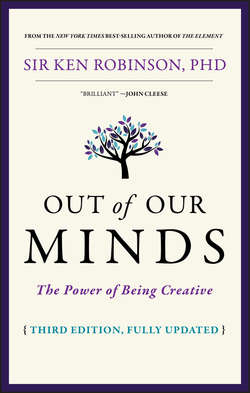Читать книгу Out of Our Minds - Робинсон Кен - Страница 10
На сайте Литреса книга снята с продажи.
1
OUT OF OUR MINDS
RETHINKING CREATIVITY
ОглавлениеTo answer these questions, it’s important to be clear about what creativity is and how it works. There are three related ideas, which I’ll elaborate as we go on. They are imagination, which is the process of bringing to mind things that are not present to our senses; creativity, which is the process of developing original ideas that have value; and innovation, which is the process of putting new ideas into practice. There are various misconceptions about creativity in particular.
“My starting point is that everyone has huge creative capacities as a natural result of being a human being. The challenge is to develop them. A culture of creativity has to involve everybody, not just a select few.”
Special people?
One misconception is that only special people are creative. This idea is reinforced by histories of creative icons like Martha Graham, Pablo Picasso, Albert Einstein, Thomas Edison, Virginia Wolf, Maya Angelou and Steve Jobs. Companies seem to think this too. They often divide the workforce into two groups: the “creatives” and the “suits.” You can normally tell who the creatives are because they don’t wear suits. They wear jeans and they come in late because they’ve been struggling with an idea. I don’t mean that the creatives are not creative. They can be highly creative, but so can anybody if the conditions are right – including the suits. Everyone has creative capacities. The challenge is to develop them. A culture of innovation has to involve everybody, not just a select few.
Special activities?
A second misconception is that creativity is about special activities, like the arts, or advertising, design or marketing. All of these can be creative, but so can anything, including science, mathematics, teaching, medicine, running a sports team or a restaurant. Some schools have “creative arts” departments. I am an uncompromising advocate of better provision for the arts in schools but creativity is not confined to the arts. Other disciplines, including science and mathematics, can be just as creative. Creativity is possible in any activity that engages our intelligence.
Companies are creative in different areas. Apple is famously good at creating new products. Wal-Mart’s creative strength is in systems, such as supply chain management and pricing. Starbucks did not invent coffee; it created a particular service culture around coffee. Actually, it did invent the $8 cup of coffee, which was a breakthrough, I thought. A culture of innovation should embrace all areas of the organization.
Letting go?
Creativity is sometimes associated with free expression, which is why some people worry about encouraging too much creativity in schools. They think of children running wild and knocking the furniture over rather than getting on with serious work. Being creative often does involve playing with ideas and having fun and enjoyment. It is also about working hard on ideas and projects, crafting them into their best forms and making critical judgments along the way about which ones work best and why. In every discipline, creativity draws on skill, knowledge and control. It’s not only about letting go, it’s about holding on.
Learning to be creative
It is often thought that people are either born creative or not, just as they may have blue or brown eyes, and there’s not much anyone can do about it. The fact is, there is a lot you can do to help yourself, and other people, become more creative. If someone tells you they can’t read or write, you don’t assume they are not capable of it, just that they haven’t learnt how. It is the same with creativity. When people say they are not creative, I just assume they have not learnt how. I also assume that they can. Why are these issues important anyway?
